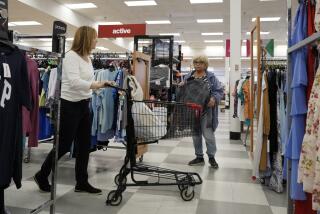5.6% Economic Growth Is Strongest Since 1987
- Share via
WASHINGTON — The nation’s economy surged this past quarter to its fastest pace in almost 10 years, the government reported Wednesday, heightening speculation on whether the Federal Reserve Board will push interest rates up again later this month in an effort to slow it down.
Commerce Department figures showed that the gross domestic product--the nation’s total output of goods and services--grew at an explosive 5.6% annual rate after adjustment for inflation, up from 3.8% the previous quarter and well above the 2% to 2.5% range that the Federal Reserve wants to see.
However, both government and private analysts said that they still expect the economy to slow somewhat in coming months, and inflation remained moderate despite the faster growth rate. Prices rose at a 2.2% annual rate during the quarter, compared to 2.6% in late 1996.
By almost any standard, announcement of the first-quarter surge in growth--to the fastest pace since late 1987--should have sent financial markets plummeting. The Fed raised interest rates by a quarter of a percentage point in March and has hinted that it may do so again if growth does not slow.
However, investors appeared to take the news in stride. Although the Dow Jones industrial average fell briefly when Wednesday’s report was issued, it quickly rebounded after analysts reevaluated the figures, ending the day at 7,008.99, up 46.96 points from Tuesday’s level.
In a view shared by many private analysts, Janet Yellin, chairwoman of the President’s Council of Economic Advisors, insisted that--while the first-quarter surge was “surprising”--the growth rate is likely to abate next quarter and inflation appears to be in check.
“We’ve got an [economic] expansion that looks like it’s got a long way to go,” she told reporters.
Nevertheless, private analysts were divided over whether last quarter’s growth rate speedup would prompt Federal Reserve policymakers to raise short-term interest rates again when they meet on May 20.
Cynthia Latta, a senior economist at DRI/McGraw-Hill, said that the new figures make an interest-rate hike more likely. “If the Fed is looking for a reason to tighten, this [report] provides one,” she said.
But Allen Sinai, president of Primark Decision Economics Inc., said that the central bank is more likely to look at “the whole array of data” coming out this week.
Sinai noted that a Labor Department report Tuesday had quashed fears that inflation would be rekindled by rising labor costs--one of the Federal Reserve’s biggest worries when it raised interest rates in March.
“The odds are significantly lower that the Fed will tighten on May 20,” Sinai said after Wednesday’s report. “More than likely, they will wait,” he predicted. “There’s no compelling reason for them to hurry.”
The government is scheduled to report Friday on the job situation nationwide. If job-growth moderates somewhat, fears about renewed inflation pressures could ease.
Wednesday’s figures showed that by far the biggest factor behind the first-quarter growth surge was a spurt in consumer spending, sparked in part by rising earnings. Outlays for personal consumption grew at a 6.4% annual rate, up from 3.4% in the last quarter of 1996.
Business purchases of new equipment also picked up during the quarter and many companies sharply increased their inventories, replenishing stocks that had been depleted in previous months.
At the same time, the growth rate was held down somewhat by a decline in federal spending levels--which plunged at a 3.5% annual rate--and by a worsening of the nation’s trade balance, as Americans imported more than they had in previous quarters.
But economists said that they expected the growth rate to begin slowing soon, as consumers return to a more traditional spending pattern and businesses reduce their inventories. Wednesday’s figures were preliminary and may be revised.
“Economic growth should moderate in the second quarter and slow more sharply by year-end,” said Bruce Steinberg, chief economist at Merrill Lynch. Despite the first-quarter surge, “the economy is not overheating,” he said.
Wednesday’s report contained a second measure of inflation that showed prices rose at a 2.7% annual rate last quarter, up from 1.9% in late 1996 but both government and private analysts dismissed it as inconsequential.
Yellin attributed the rise to the fact that the statistics did not reflect a “substantial” decline in prices of oil imports.
Both Yellin and private economists were at a loss to explain the continued surge in consumer spending, the strongest in 14 years. But many believe it already has shown signs of abating. Auto sales, for example, began declining in March.
The Fed has been worried that, if the economy continues to grow rapidly, it will drive the unemployment rate down so far that there will be a shortage of workers and businesses will have to push pay-scales higher, eventually forcing them to raise prices as well.
So far, however, despite the unusually high growth rate, the Fed’s worst fears have yet to be realized. Although wages have begun rising again, the cost of providing fringe benefits has declined. As a result, cost-pressures on firms have grown only slightly.
(BEGIN TEXT OF INFOBOX / INFOGRAPHIC)
Signs of an Upbeat Economy
The U.S. economy grew at its fastest rate in nearly a decade, with output rising at a 5.6% annual dip in the first quarter. Meanwhile, inflation appeared to be under control, and the stock market continued to rise.
AS OUTPUT RISES . . .
The quarterly rate of the GDP, which measures goods and services produced in the United States
1997
1st qtr.: 5.6%
*
. . . INFLATION DROPS . . .
1st qtr. 1996: 2.3%
2nd qtr. 1996: 2.1%
3rd qtr. 1996: 1.9%
4th qtr. 1996: 2.6%
1st qtr. 1997: 2.2%
*
More to Read
Inside the business of entertainment
The Wide Shot brings you news, analysis and insights on everything from streaming wars to production — and what it all means for the future.
You may occasionally receive promotional content from the Los Angeles Times.










